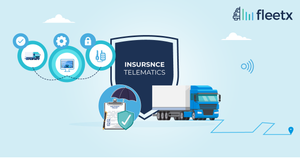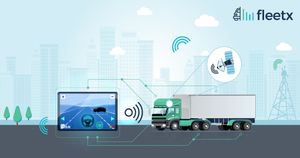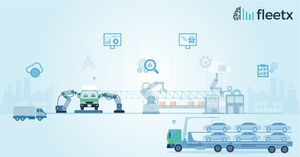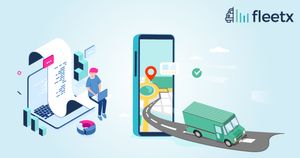
For years now, innovation in the automotive industry has been about making cars more comfortable, faster, smoother, and easier to drive. But in this new Information Age, automakers have moved to exploring ways to apply computer technology for bettering vehicle handling and offering safer driving experiences. Features like GPS sensors have now become commonplace and automakers are focusing more on telematics innovation.
Research shows that by the year 2025, over 50 to 80 billion devices will be connected to 5G in some way or the other. The 5G network has been created to enable a completely connected world and offers high-speed connections that are 100 times more powerful than the newest 4G LTE right now. 5G is essential for peer-to-peer communications that will allow vehicles to communicate directly with one another, as well as reduce latency.
Telematics industry and 5G go hand in hand
We have come a long way in terms of network and connectivity, with 5G promising to leap over even the 2Gb per second scale. Without these speeds, there are several problems the automobile industry faces due to the lack of connectivity. 4G networks experience latency issues as they are at least ten times slower than 5G, which has an almost instantaneous response time with a latency of less than 1 millisecond. Without such quick features, vehicles with heavy-duty sensors such as cameras, LIDARs, and lasers will not be able to respond in time. A 5G network is the only way to match this.
High speed connectivity is an important requirement as it allows the vehicle’s sensors to “talk” to each other, generate data, and then send it to other vehicles and networks in real-time. The huge amount of data collected and sent can be over 2 million gigabits per week, a feat that will take 4G network several months to complete.
5G integration with MaaS businesses
With 5G capabilities, vehicles can accurately estimate the time of arrival or ETA by providing average vehicle speed information. This is especially useful for MaaS (Mobility as a Service) based companies like Uber and Ola that offer transportation and mobility services based on an application. Factors such as the estimated time of arrival for these taxis are necessary so that passengers can keep track of travel times and accurately estimate when they will reach. Research by Statista shows that by 2025, the MaaS market will exceed over $230 billion dollars all over the world, making such tools an even bigger necessity.
Traditional methods for computing arrival times have relied on static information and they don’t take into account hurdles faced by vehicles on the road on a daily basis. 5G allows the creation of road network images by collating and processing huge amounts of anonymous GPS measurements that show actual consumer driving patterns, thus predicting accurate travel times.
Similarly, companies handling deliveries can also benefit from such software as customers can efficiently keep a check on where their shipped parcels are and when they will be delivered to them, i.e. estimated time of delivery. Amazon has a huge number of shipments sent out every day, the smallest delay in which can cause a huge issue for logistics. With a systematic operation in place where you can accurately collate data and predict shipping times, such a huge shipping giant can seamlessly take care of each order.
Vehicle logistics and the need for real-time data
The effects of urbanisation are being felt everywhere and the number of growing vehicles is increasing day by day, which can only mean one thing - bigger traffic jams. To remedy this, the need of the hour is route optimisation for better real-time data collection and processing.
Using 5G, automobile companies have pioneered the development of Vehicle-to-Vehicle (V2V) as well as Vehicle-to-Infrastructure (V2I) communication. Such a sophisticated level of Machine-to-Machine (M2M) transmission is very critical for vehicles to operate. Vehicles moving towards a more connected system that shares data in real-time will need a robust, fail-proof, and omnipresent wireless network that offers high data transfer speeds, ultra-low latency, extensive coverage, and zero-failure reliability - all of which is available when using 5G.
The main feature that attracts the automobile industry to 5G is its high speed, lack of latency, IoT design, as well as a transformative business model. The product of which enables routing algorithms and navigation for predicting accurate travel times, finding faster routes, as well as suggesting road alternatives. This also offers the ability to plan forward and facilitate proper route optimisation.
Autonomous driving - the future for vehicles?
Autonomous driving capabilities can further advance the benefits of connectivity that 5G has to offer. Autonomous driving entails the continual updating of software that is required to progressively deploy newer capabilities. Thus, the cloud infrastructure, connectivity, and network play an important role in dispatching these software updates. This shift to using 5G connected cars also offers automotive OEMs the ability to supplement their legacy business models with on-demand or subscription-based ones.
Teleoperation capabilities are also a big requirement to handle situations that vehicles cannot resolve autonomously. Again, increased connectivity via 5G can help with coverage, latency, uplink capacity, and QoS. For instance, due to such impressive capabilities, Tesla cars can now self-diagnose and identify issues the vehicle is experience. Not just that, this ground-breaking feature also allows the car to order the required replacement parts on its own without the user’s intervention.
Conclusion
Software-defined vehicles have the ability to deliver future-proof as well as over-dimensioned hardware capabilities. Their embedded connectivity has unlocked several features that are changing the way we use vehicles, making the experience safer and better. The addition of such radical technology is a boon and can help shape fleet management systems in a way that they are self-sufficient and autonomous. 5G is what will help in completely unlocking this potential for vehicle telematics and enhancing its effects on the MaaS and logistics industries.
How can 5G transform transportation and logistics?
The introduction of 5G will make it possible for the logistics industry to rely on more intelligent technologies, such as temperature monitoring sensors and self-driving cars. A bigger number of people will be able to connect, there will be less lag time, and there will be more coverage thanks to the tremendous speed of 5G mobile networks.
Is 5G used in Vehicle?
Vehicles can link to one another, the infrastructure, network services, and other road users including walkers and cyclists thanks to 5G auto connection. Therefore, it is possible to make roadways faster, safer, and more energy-efficient. The use of in-car entertainment will also improve the quality of travel.






